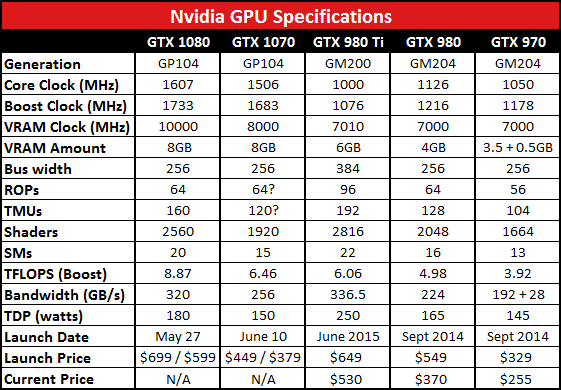Nvidia posts GTX 1070 specifications
GTX 1080's little brother displaces the 980 Ti

Now that the embargo on GTX 1080 information has passed and we've published our GTX 1080 review and performance analysis, Nvidia has posted the full specifications of their upcoming GTX 1070 to GeForce.com. We already knew a lot of what to expect, like the 8GB GDDR5 and 6.5 TFLOPS of performance, but how exactly do you get to 6.5 TFLOPS? Here are the specifications, with the GTX 1080 and some previous generation Nvidia GPUs included for comparison:

Nvidia didn't list the number of ROPs or TMUs for the 1070, but for now we're assuming it will have the same configuration at the 1080. Other than those question marks, we know pretty much everything we need to extrapolate performance. The 1070 cuts the number of SMs from 20 down to 15, with a corresponding drop in shader cores. Combined with the lower clock speed, we're looking at 28 percent lower computational performance compared to the GTX 1080, but it's also still seven percent more computational performance than a stock 980 Ti. The GDDR5 memory is clocked at 8 GHz (effective), and while we've seen plenty of overclocked 980 Ti cards reach that level and beyond, it's the first time we've seen a shipping card with such high GDDR5 clocks. The net result is 20 percent less bandwidth than the 1080, so combined we're looking at around 75-80 percent of the 1080 performance…at 63 percent of the cost (or 64 percent if you're looking at Founders Edition pricing). Either way, the result is a good combination of price and performance.
How much performance are we actually talking about, though? On paper, the 1070 has more computational performance than the 980 Ti but lower bandwidth, but the reduced bandwidth is in part overcome by the improved delta color compression in GP104. The net effect will be about 10 percent lower "real-world" bandwidth than a 980 Ti, so depending on the game the 1070 should come in just above or just below the 980 Ti. It also gives you an extra 2GB VRAM, and the TDP is 100W lower, and even with the massive drop in 980 Ti prices during the past week or two, it ends up being the better bargain. But that's only if you're looking to buy a 980 Ti; if you already have one, there shouldn't be any need to upgrade (really a lateral move) to the 980 Ti.
We're still three weeks away from the official retail launch of the GTX 1070, of course, so you can't go out and buy one even if you wanted to. More likely than not, you'll also be looking at Founders Edition pricing of $450 or more for the first couple of weeks after launch. Given the expected performance level, roughly equal to the GTX 980 Ti, it ends up being a good card but it's not going to radically change the performance landscape. If you want the fastest card around, that will still be the GTX 1080, but GTX 980 and 970, along with AMD's R9 390X/390 and Fury/Nano are all doing perfectly well at running modern games at close to maximum quality. Our advice is generally to skip a generation on GPU hardware when upgrading if you want a major jump in performance. If you have a GTX 780/770 or lower (or R9 280X/280 or lower), the new generation of graphics cards will be a great upgrade.
It's also worth noting that Nvidia has now delisted their previous generation of cards—GTX 980 Ti, 980, and 970—from their product page. The pages are still available if you link directly to them, but the 970, 980, and 980 Ti are in the process of being discontinued. No surprise there, but it does mean that prices aren't likely to fall much further before inventory dries up.
Correction: A previous version of the chart above erroneously listed 12GB VRAM for the GTX 1070.
Keep up to date with the most important stories and the best deals, as picked by the PC Gamer team.
Jarred's love of computers dates back to the dark ages when his dad brought home a DOS 2.3 PC and he left his C-64 behind. He eventually built his first custom PC in 1990 with a 286 12MHz, only to discover it was already woefully outdated when Wing Commander was released a few months later. He holds a BS in Computer Science from Brigham Young University and has been working as a tech journalist since 2004, writing for AnandTech, Maximum PC, and PC Gamer. From the first S3 Virge '3D decelerators' to today's GPUs, Jarred keeps up with all the latest graphics trends and is the one to ask about game performance.


